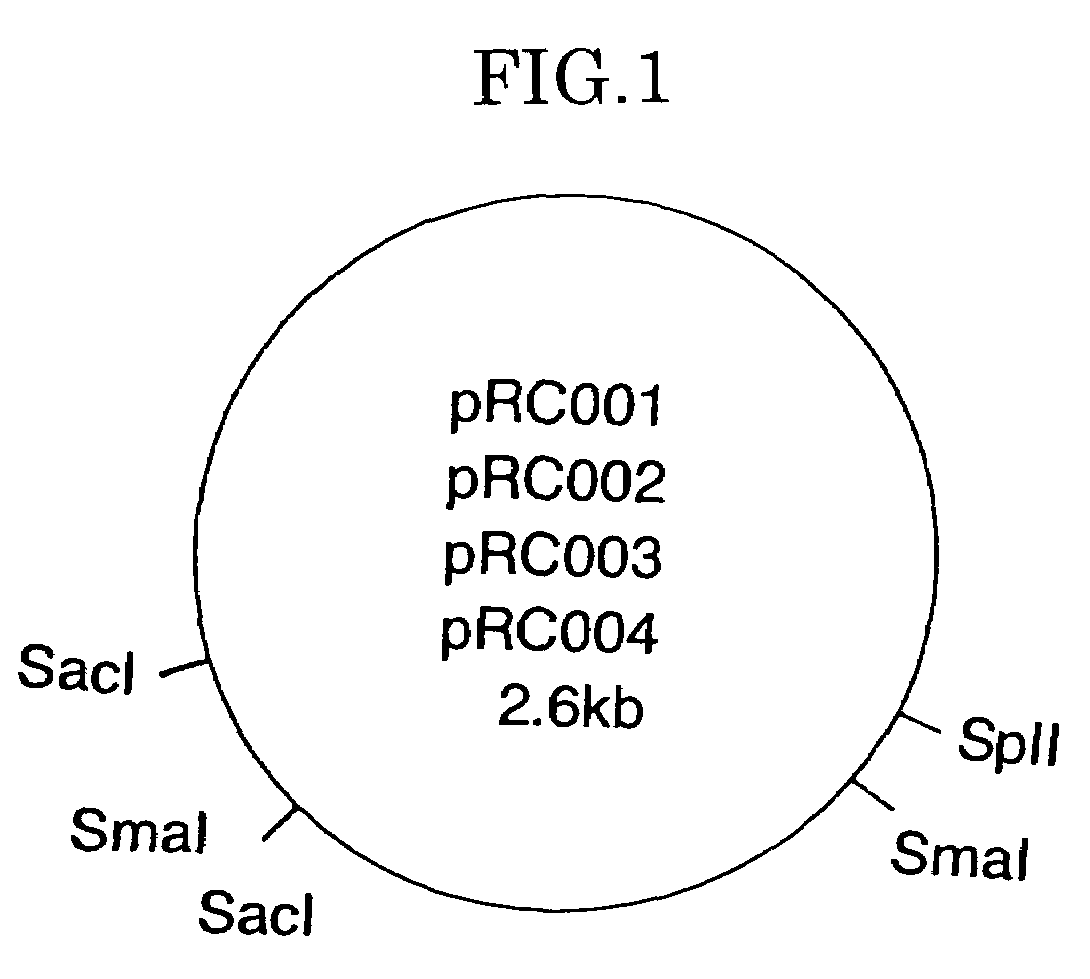DNA fragments containing gene having function relating to autonomous proliferation of plasmid
- Summary
- Abstract
- Description
- Claims
- Application Information
AI Technical Summary
Benefits of technology
Problems solved by technology
Method used
Image
Examples
example 1
[0030]Preparation of a DNA fragment of pRC004 containing a gene having a function relating to the autonomous replication of a plasmid within the bacteria of the genus Rhodococcus.
[0031]Plasmid pRC004 (1 μg) extracted from Rhodococcus rhodochrous IFO 3338 was allowed to react at 37° C. for 1 hour with 5 units of restriction enzyme Sma I or Sac I that had been added thereto, so as to cleave the plasmid DNA. The solution of the plasmid cleaved with the restriction enzyme was subjected to 0.7% agarose gel electrophoresis. From the product cleaved with Sma I, approximately 650 bp or approximately 1.9-kb DNA fraction was excised. From the product cleaved with Sac I, approximately 300 bp or approximately 2.3-kb DNA fragment was excised.
[0032]In the meantime, 0.5 μg of plasmid vector pHSG299 (TAKARA SHUZO) having a kanamycin resistance gene was allowed to react at 37° C. for 1 hour with 5 units of restriction enzyme Sma I or Sac I that had been added thereto, so as to cleave the plasmid DN...
example 2
[0041]In a manner similar to that of Example 1, plasmid pRC004 (1 μg) extracted from Rhodococcus rhodochrous IFO 3338 was allowed to react at 37° C. for 1 hour with 5 units of restriction enzymes Sma I and Sac I that had been added thereto, so as to cleave the plasmid DNA. The solution of the plasmid cleaved with the restriction enzymes was subjected to 0.7% agarose gel electrophoresis, so that an approximately 1.7-kb DNA fragment was excised.
[0042]In the meantime, 0.5 μg of plasmid vector pHSG299 (TAKARA SHUZO) having a kanamycin resistance gene was allowed to react at 37° C. for 1 hour with 5 units of restriction enzymes Sma I and Sac I that had been added thereto, so as to cleave the plasmid DNA. A one-tenth volume of 1M-Tris-HCl (pH 9.0) was added to the reaction solution, and then the resultant was allowed to react with alkaline phosphatase (1 unit) at 65° C. for 1 hour. The solution of the plasmid vector cleaved with the restriction enzymes was subjected to 0.7% agarose gel el...
example 3
[0045]The plasmid obtained in Example 2 was allowed to react at 37° C. for 1 hour with 5 units of restriction enzymes Spl I and Sma I that had been added thereto, so as to cleave the plasmid DNA. The cleaved plasmid was collected by ethanol precipitation and blunt-ended by the addition of 5 units of klenow fragments. Each component was added to the product to achieve T4 DNA ligase (1 unit), 1 mM ATP, 10 mM dithiothreitol and 10 mM MgCl2, followed by reaction at 4° C. overnight.
[0046]Escherichia coli JM105 was transformed with the above reaction solution, so that a plasmid having the above DNA fragment of approximately 1.6 kb inserted therein was obtained. Rhodococcus rhodochrous ATCC12674 was transformed by electroporation method using the obtained plasmid, so that a kanamycin-resistant transformant could be obtained.
PUM
| Property | Measurement | Unit |
|---|---|---|
| Temperature | aaaaa | aaaaa |
| Fraction | aaaaa | aaaaa |
| Fraction | aaaaa | aaaaa |
Abstract
Description
Claims
Application Information
 Login to View More
Login to View More - R&D
- Intellectual Property
- Life Sciences
- Materials
- Tech Scout
- Unparalleled Data Quality
- Higher Quality Content
- 60% Fewer Hallucinations
Browse by: Latest US Patents, China's latest patents, Technical Efficacy Thesaurus, Application Domain, Technology Topic, Popular Technical Reports.
© 2025 PatSnap. All rights reserved.Legal|Privacy policy|Modern Slavery Act Transparency Statement|Sitemap|About US| Contact US: help@patsnap.com

